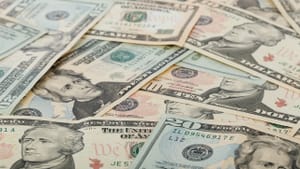Stay in the Loop
BSR publishes on a weekly schedule, with an email newsletter every Wednesday and Thursday morning. There’s no paywall, and subscribing is always free.
Why must we glorify presidents on our currency?
The great currency debate

The British have a simple, noncontroversial answer to the issues raised by the Great $20 Bill Controversy. They put a portrait of the current sovereign on all their bills.
We put portraits of our presidents on our money in imitation of a custom that started when ancient kings like Darius the Great stamped their images on their coins. Nowadays, countries like Great Britain continue the custom because their monarch is an apolitical symbol of national unity. They have separated two offices: The Queen is the head of state, and the prime minister is the head of government. The head of state takes on ceremonial roles, like the pictures that appear on stamps and bills, without being burdened by associations with particular policies. The prime minister takes political stands and dodges the flak.
Most European countries have adapted the same system. If they don’t have a hereditary monarch, they have a president who plays a similar role.
Role confusion
In the United States, our constitution combines both roles in a single office. We tend to feel superior to countries with a “mere figurehead” at the top. But the controversy over the $20 bill is an example of the conflicts created by the president’s double role. If we were merely evaluating Andrew Jackson’s place in history, we might accept the defense Dan Rottenberg offers. But the questions change when a president is assigned a royal function, such as the picture on a major bill. Should a slave-owner and Indian-killer, as Judy Weightman describes him, represent our nation?
George Orwell was a socialist, but he supported the monarchy on the grounds that it ties “leader-worship” to a figure who doesn’t have any real power. Our presidents attract that all-too-human hunger for a great leader, and our culture reinforces it with a mythology that transforms politicians into heroic figures.
Schoolchildren are taught stories about the moral virtues of the presidents. Presidential historians produce biographies that make it look like every development in American history stemmed from the actions of a president. Pundits claim the United States weathered a financial downturn because a president lifted our spirits, in the same way kings were supposed to cure the sick with their touch.
When we disagree with a president, on the other hand, our responses are intensified by the feeling the president is supposed to be our national good guy. If the president doesn’t share our personal beliefs — as all good guys must — he must be a bad guy, and we must resist his machinations with a moral crusade.
Eschew deification!
The glorification of presidents should be resisted. It’s a dangerous tendency in a democracy. We would be taking a step in the right direction if we eliminated a president from our monetary pantheon. Of the candidates mentioned as substitutes for Andrew Jackson, my favorite is Harriet Tubman. She was a private individual who rescued human beings from a terrible fate, at the risk of her life, in defiance of state and federal laws.
But why do we have to limit ourselves to figures who engaged in political action? The French bedecked their francs with artists and scientists. We don’t have the kind of cultural consensus the French do, but we might settle on Mark Twain or Walt Whitman.
If we couldn’t agree on a single person, we could follow the example of the post office and issue commemorative bills honoring a spectrum of distinguished citizens. Some of us might wince when Elvis Presley appeared on the $20 bill, but we could take comfort in the knowledge that Samuel Barber would eventually have his moment.
Calling a simoleon a simoleon
A friend of mine once offered a more lighthearted suggestion. An enterprising nation could stimulate its economy by adorning its money with images of the things you can buy with it. Imagine bills crowded with pictures of champagne bottles, cruise ships, fancy clothes, and beach party frolickers. The goodies could all be depicted in bright colors over mottos like “Live it Up!” or “Have a Ball!”
It’s what we want the money for, isn’t it? Why pretend we’re thinking about noble figures and high ideals when we contemplate those enticing pieces of paper?
The most conservative change we could make is also the most radical. We could follow the tradition of the monarchies and brand our currency with a picture of the true sovereign of our country.
Or a sovereign a sovereign
In international protocol, our president is treated as the equal of a sovereign. But our president isn’t a sovereign and our best presidents have understood that. Our president is a public official selected by the sovereign. As one of our more eloquent presidents once reminded us, we didn’t fight the American Revolution and the Civil War to establish government by presidents or even government by a Congress. We fought those wars to establish a government of, by, and for a new kind of sovereign — you and me, the sovereign people of the United States.
We couldn’t put all 315 million of us on one bill. But the Treasury Department could select individuals at random. Some of the faces on our bills might belong to decent, upstanding, hardworking citizens. Some might be portraits of scallywags or ne’er-do-wells. The luck of the draw might even produce a rich banker. They would all be part of the complicated, conflicting, eternally surprising horde that is the true source of the wealth, glories, and follies of our nation.
The treasury department announced on June 18 that a woman will be added to U.S. currency, although on the $10 bill, not the $20. More here.
Sign up for our newsletter
All of the week's new articles, all in one place. Sign up for the free weekly BSR newsletters, and don't miss a conversation.

 Tom Purdom
Tom Purdom